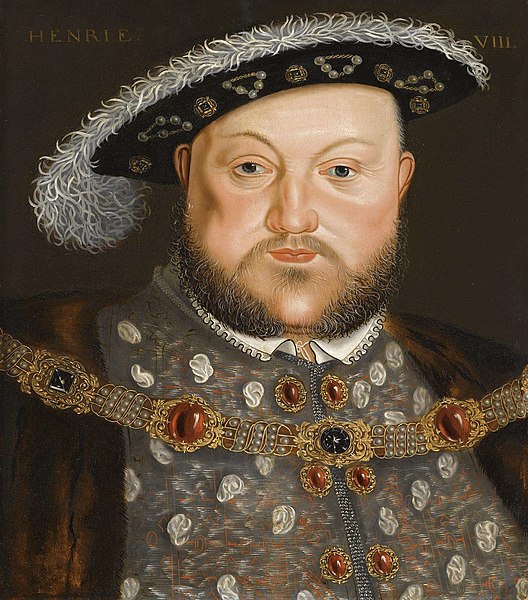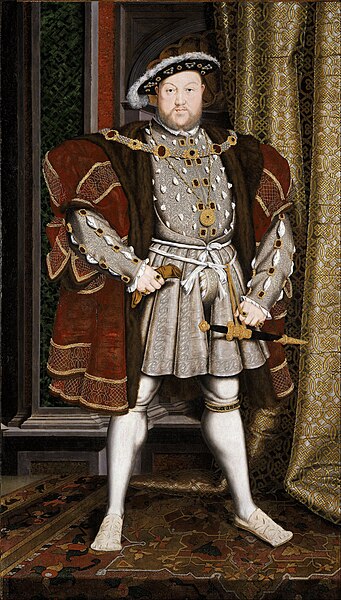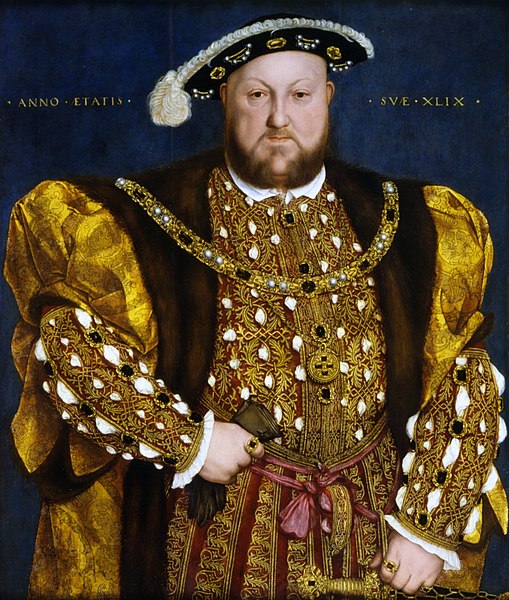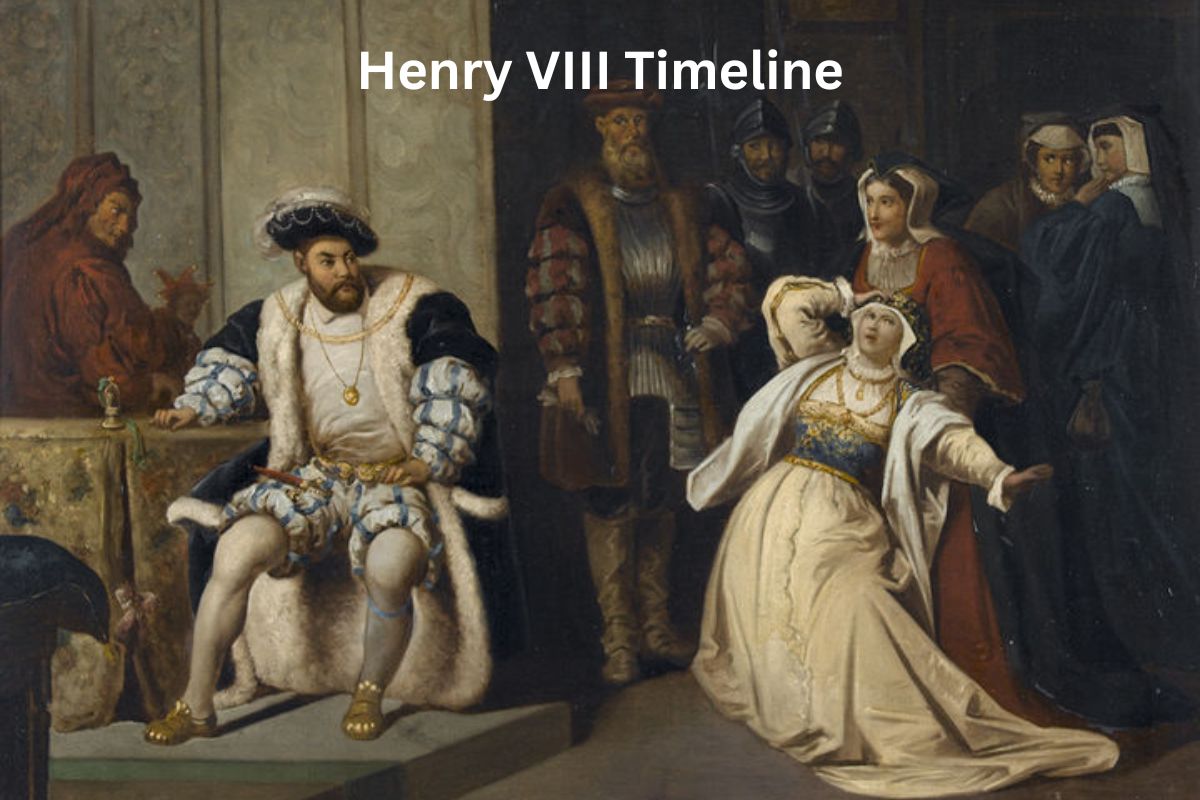Henry VIII, born in 1491, was the second Tudor king of England who reigned from 1509. He is widely recognized for his six marriages, which had a profound impact on England’s religious and political history.
Initially a staunch Catholic, he later broke from the Catholic Church in pursuit of an annulment from his first wife, Catherine of Aragon, and established the Church of England with himself as its head. His reign oversaw significant religious reforms, including the dissolution of monasteries.
Henry’s six marriages were to:
- Catherine of Aragon
- Anne Boleyn
- Jane Seymour
- Anne of Cleves
- Catherine Howard
- Catherine Parr
These unions played a central role in his life and reign. Beyond his marriages, Henry VIII expanded the English navy, consolidated his power, and was involved in European politics.
Also Read: Facts About Henry VIII
He passed away in 1547, succeeded by his son, Edward VI. Henry VIII’s legacy is marked by his complex role in the English Reformation, which forever altered England’s religious landscape.
| Year | Event |
|---|---|
| 1491 | Henry VIII is born at Greenwich Palace, London, England. |
| 1509 | Henry ascends to the throne of England after his father’s death. |
| 1509 | Henry marries Catherine of Aragon. |
| 1516 | Catherine gives birth to Mary. |
| 1517 | Martin Luther’s 95 Theses are published, sparking the Protestant Reformation. |
| 1521 | Henry receives the title “Defender of the Faith” from Pope Leo X. |
| 1525 | Henry begins an affair with Anne Boleyn. |
| 1527 | Henry seeks an annulment of his marriage to Catherine. |
| 1533 | Henry marries Anne Boleyn after an annulment. |
| 1534 | The Act of Supremacy declares Henry as the head of the Church of England. |
| 1536 | Anne Boleyn is executed. Henry marries Jane Seymour. |
| 1537 | Jane Seymour gives birth to Edward, the male heir. |
| 1540 | Henry marries Anne of Cleves, but the marriage is annulled. |
| 1540 | Henry marries Catherine Howard. |
| 1543 | Henry marries Catherine Parr. |
| 1547 | Henry VIII dies; Edward VI succeeds him as king. |
Timeline of Henry VIII
1. Birth of Henry VIII (1491)
Henry VIII was born on June 28, 1491, at Greenwich Palace in London, England. He was the second son of King Henry VII and Elizabeth of York, and from an early age, it was apparent that he would play a significant role in the history of England.
His birth brought hope to the Tudor dynasty, which had recently come to power after the tumultuous Wars of the Roses. Little did anyone know that this child would go on to become one of the most famous and influential monarchs in English history.
Also Read: Catherine of Aragon Facts
Henry’s early years were marked by a comprehensive education, including a strong emphasis on theology and classical studies, which would later shape his thinking and decisions as king.

2. Ascension to the Throne (1509)
In April 1509, at the age of 17, Henry VIII ascended to the throne of England following the death of his father, Henry VII. This transition marked the beginning of a new era for England. Young, handsome, and energetic, Henry initially enjoyed immense popularity among his subjects.
He inherited a relatively stable kingdom, largely due to his father’s careful financial management and diplomatic efforts. As a ruler, Henry was initially more interested in the arts, sports, and the pursuit of pleasure than in matters of state.
However, this would change as he grew older, and he would become increasingly involved in political and religious affairs, ultimately leaving a profound impact on England and its future course.
3. Marriage to Catherine of Aragon (1509)
One of the most significant events early in Henry VIII’s reign was his marriage to Catherine of Aragon in 1509.
Catherine was the daughter of King Ferdinand II of Aragon and Queen Isabella I of Castile, and she had previously been married to Henry’s older brother, Arthur, who had died young.
Henry’s marriage to Catherine was seen as politically advantageous, as it solidified an alliance between England and Spain. It also had religious significance, as Catherine’s marriage to Arthur had not been consummated, and a papal dispensation was obtained to allow her to marry Henry.
However, as years passed and Catherine failed to produce a male heir, Henry’s desire for a son would lead to a tumultuous period in his reign, marked by his quest for an annulment and the eventual split from the Catholic Church, culminating in the English Reformation.
4. Birth of Mary (1516)
In 1516, Henry VIII and Catherine of Aragon welcomed their first child, a daughter named Mary. Her birth was met with both joy and disappointment.
While Henry and Catherine were delighted to have an heir, the absence of a male child raised concerns about the Tudor dynasty’s future.
Also Read: Timeline of the Tudors
Mary would go on to become one of the most notable monarchs in English history, reigning as Queen Mary I, although her reign would later be remembered for its religious turmoil and persecution of Protestants.
5. “Defender of the Faith” (1521)
In 1521, Pope Leo X awarded Henry VIII the title “Defender of the Faith” for his staunch defense of Catholicism. This recognition came as a result of Henry’s writings against the Protestant Reformation, particularly his response to Martin Luther’s theological challenges.
At this point in his reign, Henry was a devout Catholic and had not yet contemplated the profound religious changes that would define the latter part of his rule. The title “Defender of the Faith” reflected his commitment to upholding traditional Catholic beliefs and practices.

6. Affair with Anne Boleyn (1525)
Around 1525, Henry VIII began a romantic relationship with Anne Boleyn, one of Catherine of Aragon’s ladies-in-waiting. Anne was a captivating and intelligent woman who captured the king’s attention.
Henry’s infatuation with Anne Boleyn would have far-reaching consequences for England, as it set in motion a series of events that would ultimately lead to the English Reformation.
His desire to marry Anne and produce a male heir would challenge the traditional authority of the Catholic Church in England.
7. Seeking an Annulment (1527)
By 1527, Henry’s marriage to Catherine of Aragon had been marred by a series of stillbirths, infant deaths, and the absence of a surviving male heir.
Frustrated by his lack of a male successor and driven by his affection for Anne Boleyn, Henry sought an annulment of his marriage to Catherine. He argued that his marriage was invalid because Catherine had previously been married to his late brother, Arthur.
This request for an annulment set off a prolonged legal and theological dispute, as well as a political struggle between Henry and the papacy.
8. Marriage to Anne Boleyn (1533)
In 1533, Henry’s quest for an annulment reached a critical point. Unable to obtain a favorable decision from the Pope, Henry took matters into his own hands.
Archbishop of Canterbury Thomas Cranmer declared Henry’s marriage to Catherine null and void, and Henry married Anne Boleyn. Anne was crowned queen, and their marriage was intended to legitimize their daughter, Elizabeth.
This marked a seismic shift in England’s religious landscape, as Henry’s break with the Catholic Church and his establishment of the Church of England were formalized.

9. The Act of Supremacy (1534)
In 1534, Henry VIII solidified his break from the authority of the Pope and the Catholic Church with the passing of the Act of Supremacy.
This act declared Henry as the supreme head of the Church of England, effectively making him the spiritual leader of the English Church and severing the country’s ties with Rome.
The English Reformation was in full swing, with monasteries dissolved, religious practices reformed, and the English clergy swearing allegiance to the king.
This momentous event forever changed the religious landscape in England and marked the birth of the Church of England, with Henry at its helm.
10. Execution of Anne Boleyn (1536)
In 1536, a mere three years after marrying Anne Boleyn, Henry VIII’s relationship with her took a tragic turn. Anne was arrested and charged with adultery, incest, and treason.
She was subsequently convicted and executed. This shocking event sent shockwaves throughout Europe and marked a dark period in Henry’s reign.
The circumstances surrounding Anne’s downfall remain debated, but it is widely believed that Henry’s desire for a male heir and growing dissatisfaction with Anne played a role in her downfall. Her execution paved the way for Henry’s next marriage.
11. Marriage to Jane Seymour (1536)
After Anne Boleyn’s execution, Henry wasted no time in seeking a new wife. In the same year, he married Jane Seymour, one of Anne’s ladies-in-waiting. Jane was well-received by both the court and the English people.
She gave birth to a son, Edward, in 1537, providing Henry with the male heir he had longed for. Tragically, Jane Seymour died shortly after childbirth, but her son Edward would later become Edward VI of England, leaving a significant legacy in English history.
12. Annulment of Marriage to Anne of Cleves (1540)
In 1540, Henry’s marriage to Anne of Cleves was annulled. This union had been politically motivated, aiming to form an alliance with the German state of Cleves. However, Henry was disappointed with Anne’s appearance and personality, which he found unattractive.
Fortunately, Anne agreed to an annulment, and the marriage was dissolved amicably. Henry and Anne remained on good terms, and she was given a generous settlement and continued to reside in England as a respected member of the royal court.
13. Marriage to Catherine Howard (1540)
Shortly after his annulment from Anne of Cleves, Henry married Catherine Howard, a young and vivacious lady-in-waiting. Unlike his previous marriages, this one was marked by significant age difference, with Catherine being in her late teens or early twenties.
However, Catherine’s past caught up with her, as it was revealed that she had engaged in premarital affairs. She was accused of adultery and subsequently executed in 1542, adding another dark chapter to Henry’s matrimonial history.
14. Marriage to Catherine Parr (1543)
In 1543, Henry VIII married Catherine Parr, his sixth and final wife. Catherine was known for her intelligence and her role in reconciling Henry with his daughters Mary and Elizabeth.
She was a devout Protestant and played a significant role in promoting religious reform in England. Remarkably, Catherine outlived Henry and went on to marry again after his death.
15. Death of Henry VIII (1547)
On January 28, 1547, Henry VIII passed away at the age of 55 at the Palace of Whitehall in London. His death marked the end of an era in English history.
He was succeeded by his young son Edward VI, whose reign was influenced by the religious changes and political turmoil initiated by his father.
Henry VIII’s complex legacy includes his role in the English Reformation, the establishment of the Church of England, and his six tumultuous marriages, which had profound implications for both England and Europe.
